Just Go With the Flow
When was the last time you told someone or you were told?

The concept “flow” was identified and extensively studied by psychologist Mihaly Csikszentmihalyi, the pioneering co-founder of positive psychology 1. According to him, flow is a state of mind in which a person becomes fully immersed in an activity. The psychological state of flow is characterised by:
Complete absorption in the task at hand
-
A merging of action and awareness
-
A loss of reflective self-consciousness
-
A sense of personal control or agency over the situation
-
A distortion of temporal experience (time seems to pass faster)
-
The experience of the activity as intrinsically rewarding
Note: Csikszentmihalyi recalled in an interview how he would watch painters in their studios and how he was fascinated by their ability to forget everything while working. He was also surprised by what happened when they were done. They’d finish a work of art, and instead of enjoying it…they would put it against the wall and start a new painting. They weren’t really interested in the finished painting. What these artists were after, Csikszentmihalyi realised, wasn’t the finished work itself but the experience of full immersion and absorption in the act of creation.
Hence, flow in the Western perspective, is typically task-specific, occurring during particular activities often associated with peak performance. Flow often involves progress toward clear goals, even if they are internally set, but is usually temporary, arising spontaneously under certain conditions. It requires a balance between high skill and high challenge and is primarily viewed through a psychological lens, focusing on well-being and performance.
From the Buddhist perspective, the state of flow is related to the unitive awareness concept. Unitive awareness in turn, is closely related to the “non-dual” consciousness concept in Buddhist philosophy. This state transcends the usual subject-object dichotomy that characterises our normal waking consciousness. In the Mahayana Buddhist tradition, this is often referred to as “advaya” or “not-two”.
While flow and unitive awareness have distinct origins and some different characteristics, they can be seen as related phenomena on a spectrum of conscious experience. According to the ancient Buddhist system of psychology, consciousness (vijñāna) is typically divided into six types, corresponding to the five senses plus the mind. Each of these consciousnesses arises in dependence on a sense organ and its corresponding object.2
However, in states of deep meditation or spontaneous insight, practitioners report experiences where these divisions dissolve. The perceiver and the perceived merge into a unified field of awareness. This is not a loss of consciousness, but rather an expansion – a state where the boundaries of self seem to dissolve, and one experiences a profound sense of interconnectedness with all phenomena.
Viewed together, we can say that:
-
Flow experiences might serve as accessible entry points for understanding and cultivating unitive awareness.
-
Buddhist mindfulness practices could potentially enhance one’s ability to enter flow states.
-
The study of flow in psychology could provide empirical approaches to understanding some aspects of unitive awareness.
-
Exploring both concepts together might offer a comprehensive understanding of optimal human experience and consciousness from both Western and Eastern perspectives.
Finding the Flow in the Blur
Building on the exploration of flow and unitive awareness, we can examine a phenomenon that emerges when we consider these states in the context of productivity.
Picture this:
You are sitting at your desk, surrounded by an arsenal of cutting-edge productivity tools. Your AI-powered smart assistant is managing your calendar, your machine learning-enhanced task manager is optimising your to-do list, and your biofeedback-enabled noise-cancelling headphones are fine-tuning your work environment. You are ready to achieve peak productivity... or are you?
Fast forward three hours, and you find yourself lost in a labyrinth of notifications, algorithmic suggestions, and AI-curated content - all somewhat related to your work, but none actually moving your projects forward. Sound familiar?
This scenario, painfully relatable to many, illustrates a key contrast in our modern, technology-driven world: the gap between our subjective experience of work and its objective outcomes. In our relentless pursuit of efficiency, we often find ourselves trapped in a web of our own making, further from our goals than when we started. This paradox deepens when we consider it in light of flow and unitive awareness states, where an effortless, timeless experience can lead to high productivity.

Here is where things get interesting. Both flow states and unitive awareness are associated with increased efficiency and effectiveness. People report working faster, with greater focus, and often producing higher quality results. Yet amusingly (at least to me), these states are characterised by a loss of time awareness and a transcendence of goal-oriented thinking.
This phenomenon challenges our conventional understanding of productivity:
-
Effortlessness vs. Effort: While traditional productivity often emphasizes conscious effort, flow states demonstrate that our highest levels of performance can feel effortless.
-
Timelessness vs. Time Management: Conventional wisdom stresses careful time management, yet in the flow, we may lose track of time while being fully immersed in work.
-
Process vs. Outcome: Flow states shift focus from the end goal to the process itself suggesting immersion in the task, contrasting with fixation of the typical goal-oriented productivity strategies.
-
Intrinsic vs. Extrinsic Motivation: The nature of flow where the activity becomes its own reward challenges productivity models based on external rewards and punishments.
The phrase “just go with the flow” takes on new meaning in this context. The synergy between flow and productivity invites us to reconsider our approach to work and achievement. It suggests that creating conditions conducive to flow might be more effective than productivity strategies focused on conscious effort and external motivators. Far from advocating passivity, it encapsulates a positive approach to engagement and productivity:
-
Adaptive Resilience: “Going with the flow” suggests flexibility in the face of changing circumstances, a crucial skill in our rapidly evolving work environments.
-
Mindful Engagement: It encourages presence and deep engagement with the current task, aligning with mindfulness practices that have been shown to enhance focus and reduce stress.
-
Natural Rhythms: This approach respects our natural energy cycles, allowing us to capitalise on periods of high focus and creativity.
-
Reduced Resistance: By not fighting against the natural flow of events, we conserve mental and emotional energy for productive pursuits.
From a teknoetic viewpoint (merging technology and noetic sciences through a Buddhist lens) - the contrasting phenomenon discussed offers a unique opportunity. It challenges us to harness our technological prowess not to do more, but to create spaces where we can lose ourselves in meaningful work. It invites us to design AI and machine learning systems that don’t just manage our time, but help us find and maintain our flow. How?
Imagine a future where your smart assistant doesn’t just optimise your calendar, but helps you identify and capitalise on your peak flow periods. Where your noise-cancelling headphones don’t just block sound, but generate audio environments scientifically proven to induce flow states. Where your task manager doesn’t just list to-dos, but structures your work to balance challenge and skill, maximising your flow potential. Is that possible and achievable?
The phenomenon teaches us that peak productivity isn’t about constant output, but about moments of deep, effortless engagement. It’s not about filling every second with activity, but about finding those precious instances where time seems to stand still, and work becomes its own reward.
In today’s digital age, perhaps our greatest challenge - and opportunity - is to embrace the contrast between the subjective experience of flow, effortless, timeless and the objective outcomes of high productivity, finding flow in the blur of our technology-driven lives. In doing so, we may discover a form of productivity that doesn’t just fill our to-do lists, but enriches our lives in profound and meaningful ways. The paradox is an invitation to dive deep into the river of our work, not fighting against the current, but moving with it - effortlessly, joyfully, productively.
-
Mihaly Csikszentmihalyi was the pioneering co-founder of the field of positive psychology. Known to many as the “father of flow”. https://www.cgu.edu/people/mihaly-csikszentmihalyi/ ↩
-
The five senses: five aggregates and consciousness and the mind (the 6th - 8th levels of consciousness). ↩